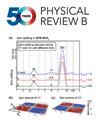具有破碎时间反向对称性的系统中贝里曲率四极杆诱发的非线性反常横向响应
IF 3.7
2区 物理与天体物理
Q1 Physics and Astronomy
引用次数: 0
摘要
最近的理论工作表明,贝里曲率的高阶矩,例如贝里曲率四极矩和六极矩,可以在具有特殊磁点群对称性的系统中产生前阶非线性反常霍尔响应(NLAH)。最近的实验工作报告称,在具有破碎时间反向对称性的外延生长材料平台中,从低温条件到室温,观察到了贝里曲率四极矩诱导的三阶非线性反常霍尔响应(即霍尔电压与外部电场的三次方成正比)。在本文中,我们使用弛豫时间近似的半经典玻尔兹曼形式主义,计算了贝里曲率四极诱导的非线性反常热霍尔和时间反转破碎系统中的奈恩斯特系数。在贝里曲率单极和偶极矩因对称性而消失的系统中,我们的结果预测了与所施加的纵向温度梯度的三次幂成正比的前阶反常热霍尔和纳恩斯特系数的行为。它们保证存在于在最近的实验中已经表现出三阶非线性反常霍尔效应的系统中。本文章由计算机程序翻译,如有差异,请以英文原文为准。
Nonlinear anomalous transverse responses induced by the Berry curvature quadrupole in systems with broken time-reversal symmetry
Recent theoretical work has shown that higher-order moments of the Berry curvature, e.g., Berry curvature quadrupole and hexapole moments, can produce the leading order nonlinear anomalous Hall response (NLAH) in systems with special magnetic point group symmetry. Recent experimental work has reported the observation of the Berry curvature quadrupole-induced third-order NLAH (i.e., Hall voltage proportional to the third power of the external electric field) from cryogenic conditions to room temperature in an epitaxially grown material platform with broken time-reversal symmetry. In this paper, using semiclassical Boltzmann formalism in the relaxation time approximation, we compute the Berry curvature quadrupole-induced nonlinear anomalous thermal Hall and Nernst coefficients in time-reversal broken systems. In systems where Berry curvature monopole and dipole moments vanish by symmetry, our results predict the behavior of the leading order anomalous thermal Hall and Nernst coefficients proportional to the third power of the applied longitudinal temperature gradient. They are guaranteed to exist in systems that have already exhibited the third-order nonlinear anomalous Hall effect in recent experiments.
求助全文
通过发布文献求助,成功后即可免费获取论文全文。
去求助
来源期刊

Physical Review B
物理-物理:凝聚态物理
CiteScore
6.70
自引率
32.40%
发文量
0
审稿时长
3.0 months
期刊介绍:
Physical Review B (PRB) is the world’s largest dedicated physics journal, publishing approximately 100 new, high-quality papers each week. The most highly cited journal in condensed matter physics, PRB provides outstanding depth and breadth of coverage, combined with unrivaled context and background for ongoing research by scientists worldwide.
PRB covers the full range of condensed matter, materials physics, and related subfields, including:
-Structure and phase transitions
-Ferroelectrics and multiferroics
-Disordered systems and alloys
-Magnetism
-Superconductivity
-Electronic structure, photonics, and metamaterials
-Semiconductors and mesoscopic systems
-Surfaces, nanoscience, and two-dimensional materials
-Topological states of matter
 求助内容:
求助内容: 应助结果提醒方式:
应助结果提醒方式:


